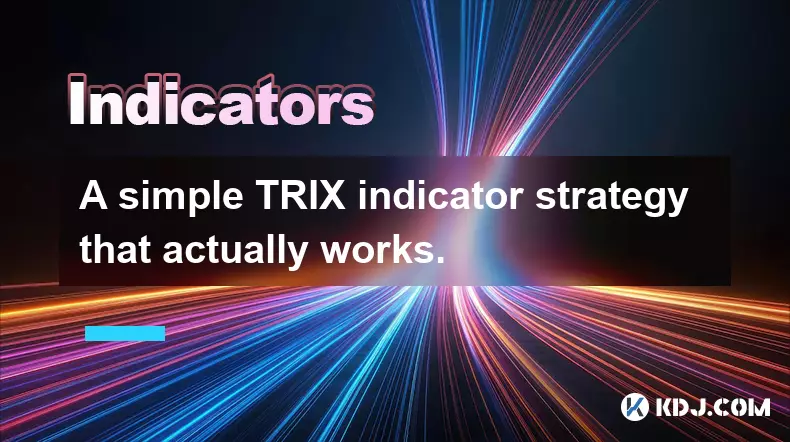-
 bitcoin
bitcoin $102877.190955 USD
1.88% -
 ethereum
ethereum $3430.435064 USD
4.52% -
 tether
tether $0.999264 USD
-0.05% -
 xrp
xrp $2.307310 USD
4.49% -
 bnb
bnb $987.740692 USD
3.82% -
 solana
solana $161.947760 USD
3.97% -
 usd-coin
usd-coin $0.999712 USD
-0.05% -
 tron
tron $0.292810 USD
2.93% -
 dogecoin
dogecoin $0.179738 USD
10.70% -
 cardano
cardano $0.580716 USD
8.75% -
 hyperliquid
hyperliquid $42.463448 USD
8.40% -
 chainlink
chainlink $15.763437 USD
7.05% -
 zcash
zcash $649.595636 USD
17.21% -
 bitcoin-cash
bitcoin-cash $511.610261 USD
7.19% -
 stellar
stellar $0.292537 USD
7.91%
Is DMI effective in time-sharing charts? Can DMI be used for intraday trading?
DMI is effective for intraday trading on time-sharing charts, helping identify trends and potential reversals, but it may generate false signals in volatile markets.
May 23, 2025 at 12:42 pm

The Directional Movement Index (DMI) is a technical indicator that traders use to determine the direction of a security's price movement and the strength of that trend. Developed by J. Welles Wilder, the DMI consists of three main components: the Positive Directional Indicator (+DI), the Negative Directional Indicator (-DI), and the Average Directional Index (ADX). This article will explore the effectiveness of the DMI in time-sharing charts and its potential for intraday trading.
Understanding the DMI Components
The DMI is composed of three primary indicators:
- +DI (Positive Directional Indicator): This measures the upward price movement over a specified period.
- -DI (Negative Directional Indicator): This measures the downward price movement over the same period.
- ADX (Average Directional Index): This quantifies the strength of the trend, regardless of direction.
Each of these components plays a crucial role in analyzing the market's directional movement. The +DI and -DI lines help traders identify the current trend, while the ADX line indicates the strength of that trend.
Effectiveness of DMI in Time-Sharing Charts
Time-sharing charts, also known as intraday charts, display price movements within a single trading day. These charts can range from 1-minute to 1-hour intervals, providing detailed insights into short-term price fluctuations.
The effectiveness of the DMI in time-sharing charts largely depends on the timeframe and the volatility of the asset being traded. For highly volatile assets like cryptocurrencies, the DMI can be particularly useful in identifying short-term trends and potential reversal points.
In time-sharing charts, the DMI can help traders by:
- Identifying Trend Direction: By comparing the +DI and -DI lines, traders can quickly determine whether the market is in an uptrend or a downtrend. When the +DI is above the -DI, it suggests a bullish trend, and vice versa for a bearish trend.
- Assessing Trend Strength: The ADX line helps traders understand the strength of the current trend. A rising ADX indicates a strengthening trend, while a falling ADX suggests a weakening trend.
- Spotting Potential Reversals: When the +DI and -DI lines cross each other, it can signal potential trend reversals. Traders can use these crossovers to enter or exit trades.
Using DMI for Intraday Trading
Intraday trading involves opening and closing positions within the same trading day. Given the short-term nature of intraday trading, the DMI can be a valuable tool for making quick and informed trading decisions.
Here’s how traders can use the DMI for intraday trading:
- Setting Up the DMI on Your Chart: Most trading platforms allow you to add the DMI as an indicator. Simply select the DMI from the list of available indicators and apply it to your time-sharing chart.
- Monitoring +DI and -DI Crossovers: Pay close attention to when the +DI crosses above the -DI (bullish signal) and when the -DI crosses above the +DI (bearish signal). These crossovers can serve as entry and exit points for trades.
- Using ADX to Filter Trades: The ADX can help filter out weak trends. A common strategy is to only take trades when the ADX is above a certain threshold, such as 25, indicating a strong trend.
- Combining DMI with Other Indicators: For more robust trading signals, consider combining the DMI with other indicators like the Relative Strength Index (RSI) or Moving Averages. This can help confirm the DMI signals and reduce false positives.
Practical Example of Using DMI in Intraday Trading
Let's walk through a practical example of using the DMI for intraday trading on a 15-minute time-sharing chart for Bitcoin (BTC).
- Identify the Trend: Start by observing the +DI and -DI lines. If the +DI is above the -DI, it suggests a bullish trend. Conversely, if the -DI is above the +DI, it indicates a bearish trend.
- Check the ADX: Look at the ADX line to assess the strength of the trend. If the ADX is above 25, it indicates a strong trend, making it a good time to consider entering a trade.
- Look for Crossovers: Monitor for crossovers between the +DI and -DI lines. A bullish crossover (when +DI crosses above -DI) could be a signal to buy, while a bearish crossover (when -DI crosses above +DI) could be a signal to sell.
- Enter and Exit Trades: Based on these signals, enter a trade when you see a bullish crossover and the ADX is above 25. Set a stop-loss order to manage risk. Exit the trade when you see a bearish crossover or when the ADX starts to decline, indicating a weakening trend.
Limitations of DMI in Intraday Trading
While the DMI can be a powerful tool for intraday trading, it is not without its limitations. Traders should be aware of the following:
- False Signals: In highly volatile markets, the DMI can generate false signals, especially on shorter timeframes. It's important to use additional confirmation indicators to validate DMI signals.
- Lag: The DMI is a lagging indicator, meaning it reacts to price movements rather than predicting them. This can result in delayed entry and exit signals.
- Overtrading: The frequent crossovers on short-term charts can lead to overtrading, increasing transaction costs and potential losses. Traders should be cautious and use the DMI in conjunction with a well-defined trading plan.
Optimizing DMI Settings for Intraday Trading
To maximize the effectiveness of the DMI in intraday trading, traders can experiment with different settings:
- Adjusting the Period: The default period for the DMI is typically 14 periods. For intraday trading, you might find better results by using shorter periods, such as 5 or 10, to capture more immediate price movements.
- Setting Thresholds: Experiment with different ADX thresholds to find the level that best suits your trading style. Some traders prefer higher thresholds, such as 30, to filter out weaker trends.
- Combining with Other Indicators: As mentioned earlier, combining the DMI with other indicators can help confirm signals and improve trading accuracy. For example, using the RSI to confirm overbought or oversold conditions can enhance the reliability of DMI signals.
Frequently Asked Questions
Q: Can the DMI be used effectively on all cryptocurrencies?A: The effectiveness of the DMI can vary depending on the volatility and trading volume of the cryptocurrency. For highly liquid and volatile assets like Bitcoin and Ethereum, the DMI can be quite effective. However, for less liquid cryptocurrencies, the DMI might generate more false signals due to erratic price movements.
Q: How often should I check the DMI signals during intraday trading?A: The frequency of checking DMI signals depends on the timeframe you are using. For 1-minute or 5-minute charts, you might need to monitor the signals continuously. For 15-minute or 1-hour charts, checking every few minutes or at key market times (e.g., market open, close, and major news releases) may be sufficient.
Q: Is it necessary to use the DMI with other indicators for intraday trading?A: While it's possible to use the DMI alone, combining it with other indicators can significantly improve the accuracy of your trading signals. Indicators like the RSI, Moving Averages, or Bollinger Bands can help confirm DMI signals and reduce the risk of false positives.
Q: Can the DMI be used for swing trading as well as intraday trading?A: Yes, the DMI can be used for swing trading, which involves holding positions for several days to weeks. For swing trading, you might use longer timeframes, such as daily or weekly charts, and adjust the DMI settings accordingly to capture broader market trends.
Disclaimer:info@kdj.com
The information provided is not trading advice. kdj.com does not assume any responsibility for any investments made based on the information provided in this article. Cryptocurrencies are highly volatile and it is highly recommended that you invest with caution after thorough research!
If you believe that the content used on this website infringes your copyright, please contact us immediately (info@kdj.com) and we will delete it promptly.
- Ripple (XRP) in 2026: Hold or Fold? A Look at XRP's Future and Emerging DeFi Alternatives
- 2025-11-08 18:35:01
- Zcash ZEC Coin Price Explosion: From Privacy Niche to Center Stage
- 2025-11-08 18:55:01
- Berachain Price Prediction: Navigating the Honeycomb Hype in Crypto
- 2025-11-08 18:55:01
- Arthur Hayes, Gold, and Bitcoin: A Modern Monetary Trinity?
- 2025-11-08 19:15:01
- Shiba Inu's Next Move: Navigating a Shifting Market
- 2025-11-08 19:20:01
- Pakistan's Crypto Crossroads: Balancing Opportunity with Asset-Backed Realities
- 2025-11-08 19:20:01
Related knowledge

How do professional traders use the TRIX indicator?
Nov 06,2025 at 04:40pm
Understanding the TRIX Indicator in Crypto TradingThe TRIX (Triple Exponential Average) indicator is a momentum oscillator used by professional trader...

Can I use the TRIX indicator on my mobile trading app?
Nov 07,2025 at 07:40pm
The TRIX indicator, a momentum oscillator designed to filter out short-term fluctuations and highlight long-term trends, has become increasingly popul...

How to code a simple TRIX indicator script in Pine Script?
Nov 07,2025 at 06:20am
How to Code a Simple TRIX Indicator in Pine Script The TRIX (Triple Exponential Moving Average) indicator is widely used in cryptocurrency trading to ...

A simple TRIX indicator strategy that actually works.
Nov 08,2025 at 05:39pm
Understanding the TRIX Indicator in Crypto Trading1. The TRIX (Triple Exponential Average) indicator is a momentum oscillator designed to filter out s...

How to trade TRIX indicator signals on the 1-hour chart?
Nov 07,2025 at 05:39am
Bitcoin's Role in Decentralized Finance1. Bitcoin remains the cornerstone of decentralized finance, serving as a benchmark for value and security acro...

Can the TRIX indicator be used for long-term investing?
Nov 06,2025 at 02:19pm
Understanding the TRIX Indicator in Cryptocurrency Markets1. The TRIX (Triple Exponential Average) indicator is a momentum oscillator designed to filt...

How do professional traders use the TRIX indicator?
Nov 06,2025 at 04:40pm
Understanding the TRIX Indicator in Crypto TradingThe TRIX (Triple Exponential Average) indicator is a momentum oscillator used by professional trader...

Can I use the TRIX indicator on my mobile trading app?
Nov 07,2025 at 07:40pm
The TRIX indicator, a momentum oscillator designed to filter out short-term fluctuations and highlight long-term trends, has become increasingly popul...

How to code a simple TRIX indicator script in Pine Script?
Nov 07,2025 at 06:20am
How to Code a Simple TRIX Indicator in Pine Script The TRIX (Triple Exponential Moving Average) indicator is widely used in cryptocurrency trading to ...

A simple TRIX indicator strategy that actually works.
Nov 08,2025 at 05:39pm
Understanding the TRIX Indicator in Crypto Trading1. The TRIX (Triple Exponential Average) indicator is a momentum oscillator designed to filter out s...

How to trade TRIX indicator signals on the 1-hour chart?
Nov 07,2025 at 05:39am
Bitcoin's Role in Decentralized Finance1. Bitcoin remains the cornerstone of decentralized finance, serving as a benchmark for value and security acro...

Can the TRIX indicator be used for long-term investing?
Nov 06,2025 at 02:19pm
Understanding the TRIX Indicator in Cryptocurrency Markets1. The TRIX (Triple Exponential Average) indicator is a momentum oscillator designed to filt...
See all articles





















![The Graph Price Prediction [GRT Crypto Price News Today] The Graph Price Prediction [GRT Crypto Price News Today]](/uploads/2025/11/07/cryptocurrencies-news/videos/690d4df44fe69_image_500_375.webp)



















































